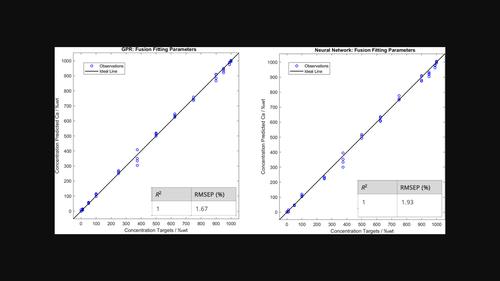当前位置:
X-MOL 学术
›
J. Raman Spectrosc.
›
论文详情
Our official English website, www.x-mol.net, welcomes your feedback! (Note: you will need to create a separate account there.)
Machine learning methods applied to combined Raman and LIBS spectra: Implications for mineral discrimination in planetary missions
Journal of Raman Spectroscopy ( IF 2.5 ) Pub Date : 2023-11-03 , DOI: 10.1002/jrs.6611 Sofía Julve‐Gonzalez 1 , Jose A. Manrique 1, 2 , Marco Veneranda 1 , Iván Reyes‐Rodríguez 1 , Elena Pascual‐Sanchez 1 , Aurelio Sanz‐Arranz 1 , Menelaos Konstantinidis 3 , Emmanuel A. Lalla 3, 4 , María E. Charro 1 , Eduardo Rodriguez‐Gutiez 1 , José M. Lopez‐Rodríguez 1 , José F. Sanz‐Requena 1 , Jaime Delgado‐Iglesias 1 , Manuel A. Gonzalez 1 , Fernando Rull 1 , Guillermo Lopez‐Reyes 1
Journal of Raman Spectroscopy ( IF 2.5 ) Pub Date : 2023-11-03 , DOI: 10.1002/jrs.6611 Sofía Julve‐Gonzalez 1 , Jose A. Manrique 1, 2 , Marco Veneranda 1 , Iván Reyes‐Rodríguez 1 , Elena Pascual‐Sanchez 1 , Aurelio Sanz‐Arranz 1 , Menelaos Konstantinidis 3 , Emmanuel A. Lalla 3, 4 , María E. Charro 1 , Eduardo Rodriguez‐Gutiez 1 , José M. Lopez‐Rodríguez 1 , José F. Sanz‐Requena 1 , Jaime Delgado‐Iglesias 1 , Manuel A. Gonzalez 1 , Fernando Rull 1 , Guillermo Lopez‐Reyes 1
Affiliation

|
The combined analysis of geological targets by complementary spectroscopic techniques could enhance the characterization of the mineral phases found on Mars. This is indeed the case with the SuperCam instrument onboard the Perseverance rover. In this framework, the present study seeks to evaluate and compare multiple machine learning techniques for the characterization of carbonate minerals based on Raman-LIBS (Laser-Induced Breakdown Spectroscopy) spectroscopic data. To do so, a Ca-Mg prediction curve was created by mixing hydromagnesite and calcite at different concentration ratios. After their characterization by Raman and LIBS spectroscopy, different multivariable machine learning (Gaussian process regression, support vector machines, ensembles of trees, and artificial neural networks) were used to predict the concentration ratio of each sample from their respective datasets. The results obtained by separately analyzing Raman and LIBS data were then compared to those obtained by combining them. By comparing their performance, this work demonstrates that mineral discrimination based on Gaussian and ensemble methods optimized the combine of Raman-LIBS dataset outperformed those ensured by Raman and LIBS data alone. This demonstrated that the fusion of data combination and machine learning is a promising approach to optimize the analysis of spectroscopic data returned from Mars.
中文翻译:

应用于组合拉曼和 LIBS 光谱的机器学习方法:对行星任务中矿物辨别的影响
通过互补光谱技术对地质目标进行综合分析可以增强对火星上发现的矿物相的表征。毅力号火星车上的 SuperCam 仪器确实就是这种情况。在此框架中,本研究旨在评估和比较基于拉曼-LIBS(激光诱导击穿光谱)光谱数据表征碳酸盐矿物的多种机器学习技术。为此,通过以不同浓度比混合水菱镁矿和方解石来创建 Ca-Mg 预测曲线。通过拉曼光谱和 LIBS 光谱进行表征后,使用不同的多变量机器学习(高斯过程回归、支持向量机、树集成和人工神经网络)来根据各自的数据集预测每个样品的浓度比。然后将分别分析拉曼和 LIBS 数据获得的结果与组合它们获得的结果进行比较。通过比较它们的性能,这项工作表明,基于高斯和集成方法的矿物判别优化了拉曼-LIBS 数据集的组合,优于仅由拉曼和 LIBS 数据确保的结果。这表明数据组合和机器学习的融合是优化火星返回光谱数据分析的一种有前途的方法。
更新日期:2023-11-03
中文翻译:

应用于组合拉曼和 LIBS 光谱的机器学习方法:对行星任务中矿物辨别的影响
通过互补光谱技术对地质目标进行综合分析可以增强对火星上发现的矿物相的表征。毅力号火星车上的 SuperCam 仪器确实就是这种情况。在此框架中,本研究旨在评估和比较基于拉曼-LIBS(激光诱导击穿光谱)光谱数据表征碳酸盐矿物的多种机器学习技术。为此,通过以不同浓度比混合水菱镁矿和方解石来创建 Ca-Mg 预测曲线。通过拉曼光谱和 LIBS 光谱进行表征后,使用不同的多变量机器学习(高斯过程回归、支持向量机、树集成和人工神经网络)来根据各自的数据集预测每个样品的浓度比。然后将分别分析拉曼和 LIBS 数据获得的结果与组合它们获得的结果进行比较。通过比较它们的性能,这项工作表明,基于高斯和集成方法的矿物判别优化了拉曼-LIBS 数据集的组合,优于仅由拉曼和 LIBS 数据确保的结果。这表明数据组合和机器学习的融合是优化火星返回光谱数据分析的一种有前途的方法。



























 京公网安备 11010802027423号
京公网安备 11010802027423号